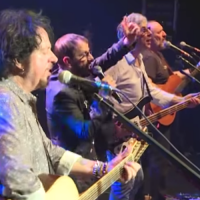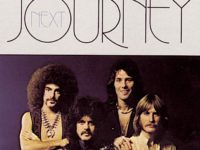When you hear things like “the boys are getting back together” it typically brings a lot of hype followed by disappointment. It’s just hard to recapture that old magic forged in a certain, special time, under unique circumstances. But Carlos Santana and some old friends were determined to avoid that kind of letdown, and now they’re poised to show the world that on April 15, 2016 when Santana IV goes on sale (Thirty Tigers).
That title itself is an announcement that forty-five years after the platinum-selling Santana III, the (mostly) same band lineup has finally prepared a proper follow-up album. Santana is reunited with guitarist Neal Schon, keyboardist/vocalist Gregg Rolie, drummer Michael Shrieve and percussionist Michael Carabello for the first time since 1971 (Schon, Shrieve and Rolie carried on until the next album Caravanserai before Schon and Rolie left to form Journey). Present-day Santana members Karl Perazzo (percussion) and Benny Rietveld (bass) round out this fortified group.
IV wasn’t the first attempt at recapturing the spirit of III: Abraxas Pool was a one-off project from ’97 that featured Rolie, Schon, Carabello and Shrieve…but no Carlos. However, Schon didn’t give up on the dream of reuniting the ’71 lineup, and finally got the titular head on board in 2013. From there, a flurry of activity commenced when they quickly found their old cohesion and before they knew it, they had created some 40 or so songs. Distilling it all down to a ‘mere’ sixteen tracks in 75 minutes — a double platter in the vinyl age — Santana IV doesn’t always sound like 1971, but that’s less important than that the process used to create this music is similar to how it was made back then. These aren’t songs per se; they’re jams.
Latin-spiced jams, too. “Yambu” is an instrumental where the percussion right off reminds you of the unique elements Santana brought rock, along with those Afro-Cuban chants. The production might place it in the present time save for Rolie’s churning B3, but it’s that old feeling. The first advance single “Anywhere You Want To Go” conforms closer to the classic sound, more than coincidentally similar to “Oye Como Va” and Rolie has lost nothing in terms of songwriting and his underrated laid-back soulful vocals, which remain in good form here and also on the “Evil Ways” sound-alike “Leave Me Alone” and the aching blues ballad “Blues Magic,” where Carlos plays with some pretty inspired passion.
It goes without saying, but Schon today is a much more developed and polished guitarist than he was as a teenaged prodigy who chose to play in Santana over Eric Clapton’s band, and he now performs as virtually a full equal to Carlos. The chemistry between the two is one area where the band got better and these old hands have the insight and maturity to complement, not compete with, each other. It’s the very thing that makes the instrumental “Fillmore East” a treat, both holding a personal conversation speaking in the jazz-rock language that they share. A more relaxed vibe pervades “Forgiveness,” a song that seemed to have sprung forth from the guitarists’ tasteful noodlings to find its groove organically. On an even softer side is “Sueños,” a virtual rewrite of “Europa (Earth’s Cry Heaven’s Smile)” from the 1976 LP Amigos. A poetic nylon string lead alternates with an equally passionate electric one, and lushed up with strings backing.
Greg Walker and Alex Ligertwood were a fine vocalists for Santana back in the mid 70s-early 80s who like many soul crooners of the time owed much to Ronald Isley, so to get The Man himself is another case where Santana outdid even their old selves. And the self-proclaimed Mr. Biggs did not disappoint. “Love Makes The World Go Round” easily recalls the time when the union between soul and rock was strong, thanks to bands like both the Isley Brothers and Santana. Throw in those classic Carlos licks and 70s music fans should have every reason to rejoice. Isley also cameos on “Freedom On Your Mind,” a four-on-the-floor tune where Schon and Carlos take turns on solos in an extended instrumental section.
Santana IV isn’t going to rank among Santana’s finest albums, but it represents the best that Santana can make right now, and it’s commendable that a legend with nothing left to prove since about 1971 gave in to the passion of his golden era and made music with a hunger Carlos Santana hadn’t shown in decades. Even if all this record accomplished was to remind us of what made the Santana band so groundbreaking, influential and appealing back when it was creating a stir at Woodstock and dominating the radio, this could be called a success. It does that, plus a little bit more.
- Dave Douglas, feat. James Brandon Lewis – ‘Gifts’ (2024) - April 11, 2024
- Thollem – ‘Worlds In A Life, Two’ (2024) - April 8, 2024
- Oceans And [Tim Berne, Hank Roberts + Aurora Nealand] – ‘Lucid/Still’ (2024) - April 3, 2024




